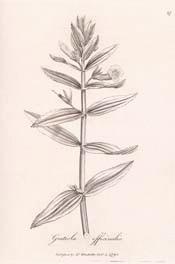
Botanical.com Home Page

|
Hyssop, Hedge
(Gratiola officinalis LINN.)
Click on graphic for larger image
|
Hyssop, Hedge
Botanical: Gratiola officinalis (LINN.)
Family: N.O. Scrophulariaceae
---Parts Used---Root, herb.
---Description---Hedge-Hyssop was formerly an official drug. The root and herb are still used in herbal medicine.
The plant, a perennial, is a native of the south of Europe, growing in meadows and moist grounds. The square stem rises from a creeping, scaly rhizome to the height of 6 to 12 inches, and has opposite stalkless, lanceshaped, finely serrate, smooth, pale-green leaves, and whitish, or reddish flowers, placed singly in the axils of the upper pairs of leaves, the corollas two-lipped, with yellow hairs in the tube.
The plant is inodorous, but has a bitter, nauseous, somewhat acrid taste, which earns it the name of Hedge Hyssop.
---Constituents---Its active constituent is the bitter crystalline glucoside Gratiolin and a reddish, amorphous, bitter principle, Gratiosolin, likewise a glucoside.
---Medicinal Action and Uses---A drastic cathartic and emetic, possessing also diuretic properties. Has been used for the relief of dropsy, and is recommended in scrofula, chronic affections of the liver, jaundice, and enlargement of the spleen, and as a worm dispeller.
---Preparations---The infusion of 1/2 oz. of powdered root is taken in tablespoonful doses. Powdered root, 15 to 30 grains.
Gratiola officinalis was in former times called Gratia Dei, on account of its active medicinal properties. In large doses it is said to be poisonous. Haller says that the abundance of this plant in some of the Swiss meadows renders it dangerous to allow cattle to feed in them. G. peruviane has similar properties.' (Treasury of Botany.)
The tropical American herb Vandellia diffusa (Linn.) is used like Gratiola. The dried plant has a strong odour of tobacco.
A decoction of V. diffusa is employed medicinally in Guiana in fevers and disorders of the liver. The species are natives of the East Indies, China, Burma, and South America. Some of them are grown in this country. The generic name commemorates a Professor of Botany at Lisbon.
Curanga amara (Juss.), known as Herpestis amara (Benth.) and Gratiola amara (Roxb.), yields the important East Indian tonic and febrifuge Curanja or Koen-tao-tjao. It contains the bitter alcohol-soluble glucoside curanjiin.
Bonnaya rotundifolia (Benth.) is the East Indian Tsjanga-puspam used as an antispasmodic.
Scoparia dulcis (Linn.), a common weed of tropical America, is used as an astringent and antispasmodic under the name Vacourinha.
Many other species, native to different parts of the world, belonging to this family, are in medicinal use in a lesser degree. Nearly all of them contain bitter substances, and many possess anthelmintic properties.
[Top]
Common Name Index
A MODERN HERBAL Home Page
Bear in mind "A Modern Herbal" was written with the conventional wisdom of the early 1900's. This should be taken into account as some of the information may now be considered inaccurate, or not in accordance with modern medicine.
© Copyright Protected 1995-2025 Botanical.com
|

